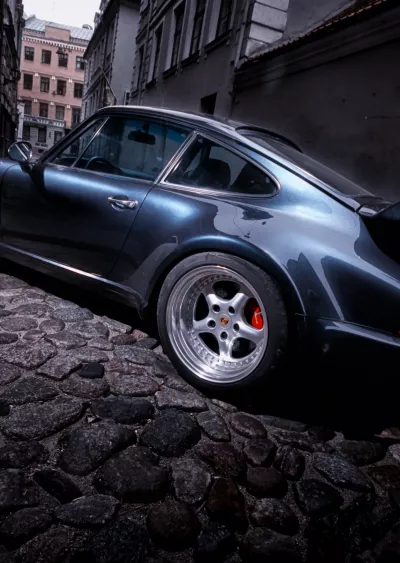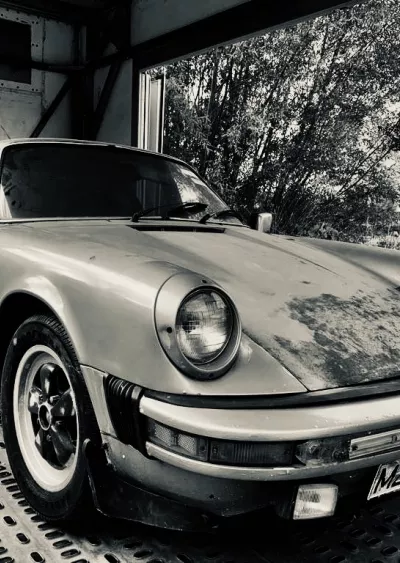Explosive all-weather acceleration
The 911 Turbo Coupe is defined by its astounding powerplant. The 3.6-liter horizontally opposed six-cylinder engine features twin turbochargers and readily delivers an awesome 480 horsepower and a locomotive-like 460 lb.-ft. (624 Nm) of torque. When equipped with the optional Sports Chrono Turbo feature with Overboost, the driver actually has bursts of 505 lb.-ft. (685 Nm) of torque available.
The engine's stunning potential is channeled to all four wheels via Porsche Traction Management (PTM) all-wheel drive. This electronically controlled system can vary the torque split infinitely and absolutely between front and rear wheels as needed for optimum traction. Wheel slip is further reined in by Porsche Stability Management (PSM) which is standard on all Turbos.
Driving through either a standard-equipment six-speed manual or optional five-speed Tiptronic S transmission, the Turbo Coupe drives from zero to 60 mph in a 3.7 second blur. When equipped with the Tiptronic S, the Turbo Coupe gets to 60 mph in 3.4 seconds. That's 0.3 second faster than the experienced Porsche test drivers could make the run with the manual gearbox. This superior acceleration of the automatic transmission is another example of Porsche's engineers bringing higher levels of performance to a broad range of skilled drivers.
Keeping the weight down
When equipped with the manual gearbox, the Turbo Coupe has curb weight of only 3494 pounds (1585 kg). The Tiptronic S model weighs but 78 pounds (35 kg) more, 3572 pounds (1620 kg).
The Turbo Coupe's monocoque structure carries a mostly hot-galvanized steel body with a light- alloy front decklid and aluminum doors. These doors weigh only 24 pounds (11 kg) each, a reduction of 31 pounds (14 kg) over the standard steel doors. The doors rest on a light-alloy pressure-cast frame, which is visible at certain points without any surface cover, a feature unique to the Turbo. This frame also eases manufacturing complexity by reducing the number of individual door components to just five.
Astounding output per liter
As with every Porsche Turbo sports car before it, the heart of the new 911 Turbo Coupe lies behind the passenger compartment: The unique Porsche turbocharged six-cylinder engine.
The 3.6-liter flat six develops 480 bhp (353 kW) at 6000 rpm, or an awesomely efficient 133 bhp (98.1 kW) per liter. Given the Coupe's low 3494-pound mass (for the manual gear box model), the 911 Turbo Coupe has an outstanding power-to-weight ratio of only 7.28 pounds/hp.
But knowing full well that torque is what moves the automotive world, Porsche engine designers developed a twin turbocharged engine that offers a peak torque of 460 lb.-ft. (624 Nm) available over an extremely broad range, from 1950 rpm to 5000 rpm. The optionally available Overboost feature briefly ups the torque peak to 505 lb.-ft. (685 Nm) from 2100 rpm to 4000 rpm.
Power on tap, instantly
Key to the turbocharged engine's potent efficiency is the use of variable turbine geometry (VTG). Essentially, VTG uses constantly adjustable turbine blades to vary the turbine's cross-section precisely to the exhaust flow regardless of engine load and/or speed.
At low rpm, the blades close to form small air gaps. This causes the exhaust gases flowing through the small cross-section to accelerate, spinning the turbine quickly—as though it were a small, low rotating mass turbocharger. At higher rpm, with its inherently greater exhaust-gas flow, the turbine blades open, increasing their cross-sections and simultaneously lowering turbine speed, maintaining a constant intake charge pressure.
The full range of movement of the turbine blades takes merely 100 milliseconds and is controlled by the engine's Motronic® electronic control module (ECM). Action of the variable turbo vanes is so precise that there's no need for a turbocharger bypass valve to limit maximum boost. To reduce excess boost pressure on the throttle butterfly when the driver quickly lifts off the throttle or in overrun, the Turbo features an automatic bypass valve which saves space via a new placement on the compressor housing.
The intake charge from each of the engine's two turbochargers is cooled by a dedicated intercooler, each located ahead of a rear wheel, as has been a Porsche Turbo hallmark.
The result of this sophisticated engineering and complex manufacturing is a turbocharged engine that responds to the driver's demand for more power immediately. There is no time lag between stepping on the throttle and the expected rush forward of boost. In fact, the VTG delivers its rewarding surge of power as quickly as an engine with a mechanically driven supercharger, but without the penalty of the supercharger's parasitic power drain on the engine.
More for those who want it
To ensure the expected high level of engine response and long life, maximum intake pressure is set to approximately 14.5 psi, or 1 bar. The optional Overboost feature briefly allows approximately ten-second bursts of 17.4 psi or 1.2 bar, at the touch of a console-mounted button. On-the-road tests show that with Overboost, 50 to 75 mph (80 to 120 kmph) passing time— without downshifting from second highest gear—is just 3.6 seconds, vs. 3.9 seconds without the use of Overboost.
Porsche engineers measure boost levels at sea level, under full load and at an ambient temperature of 68°F (20°C).







